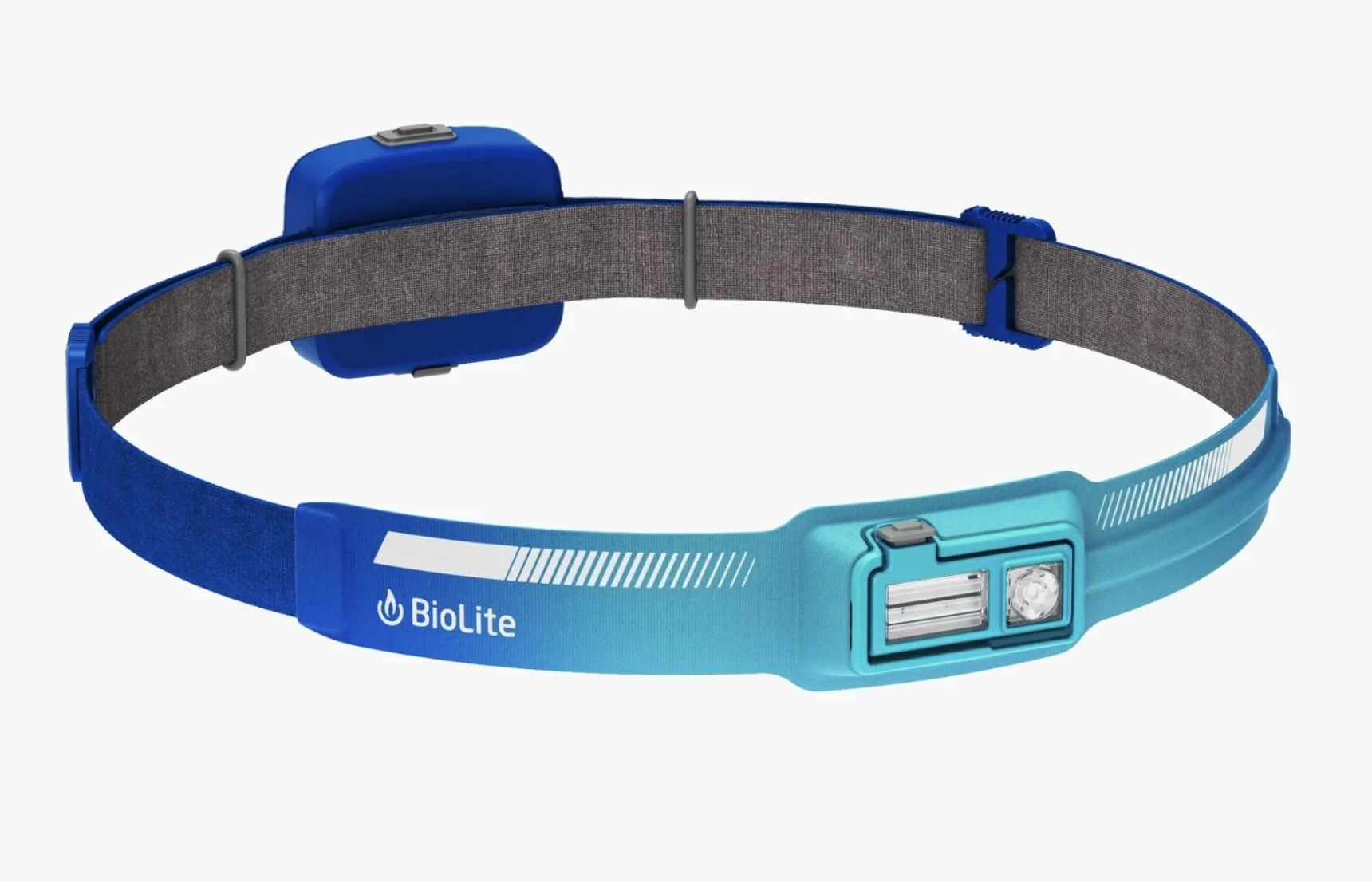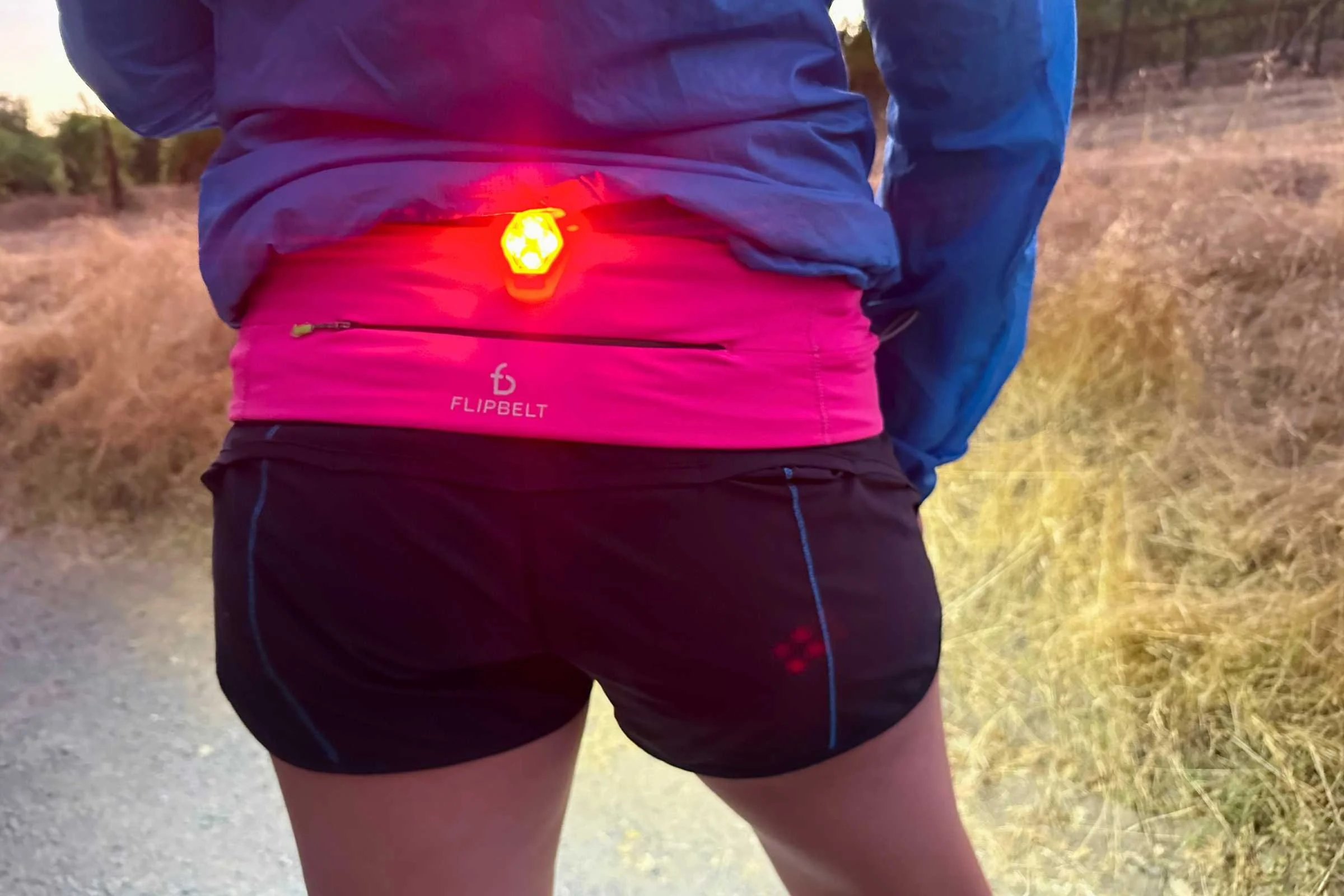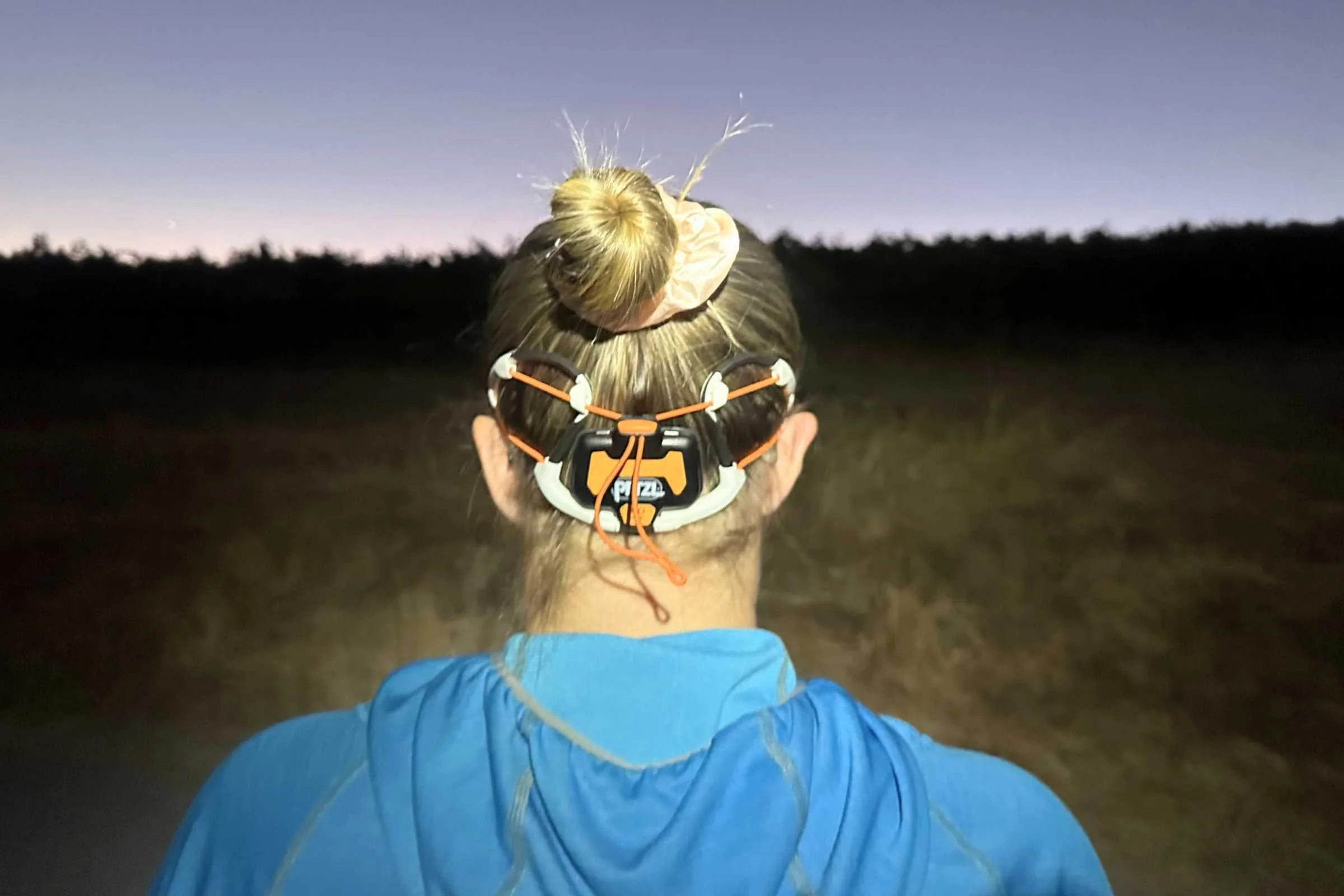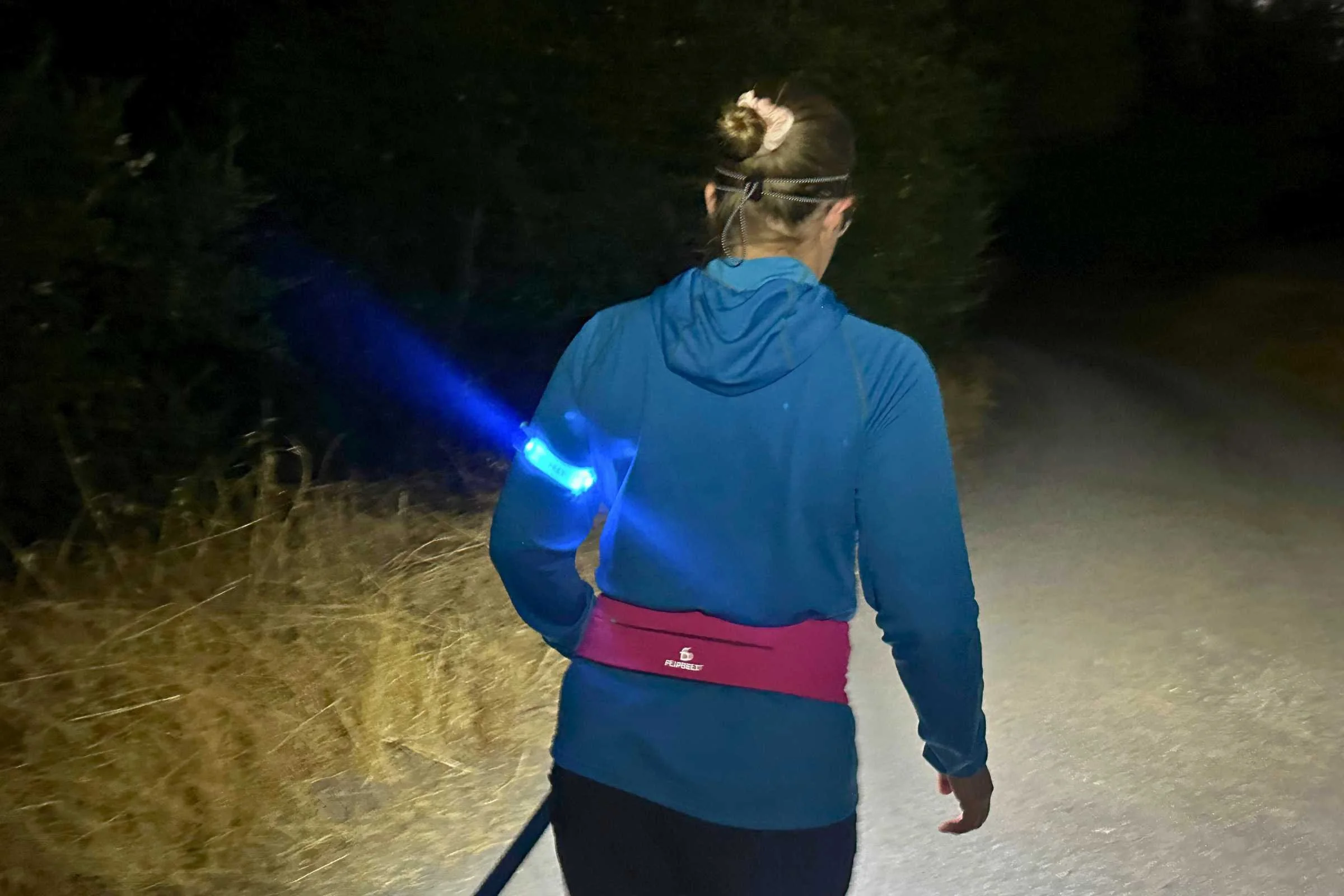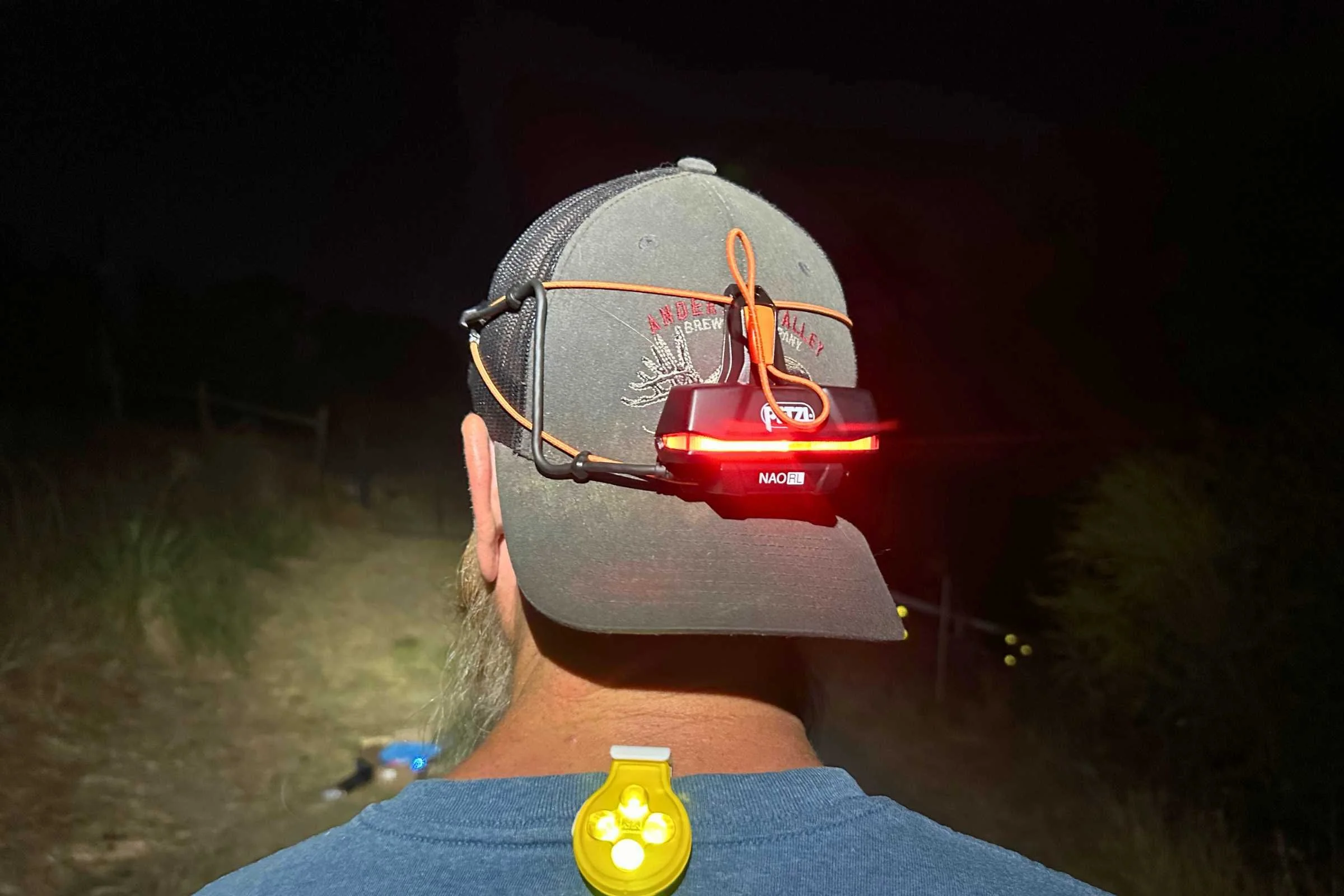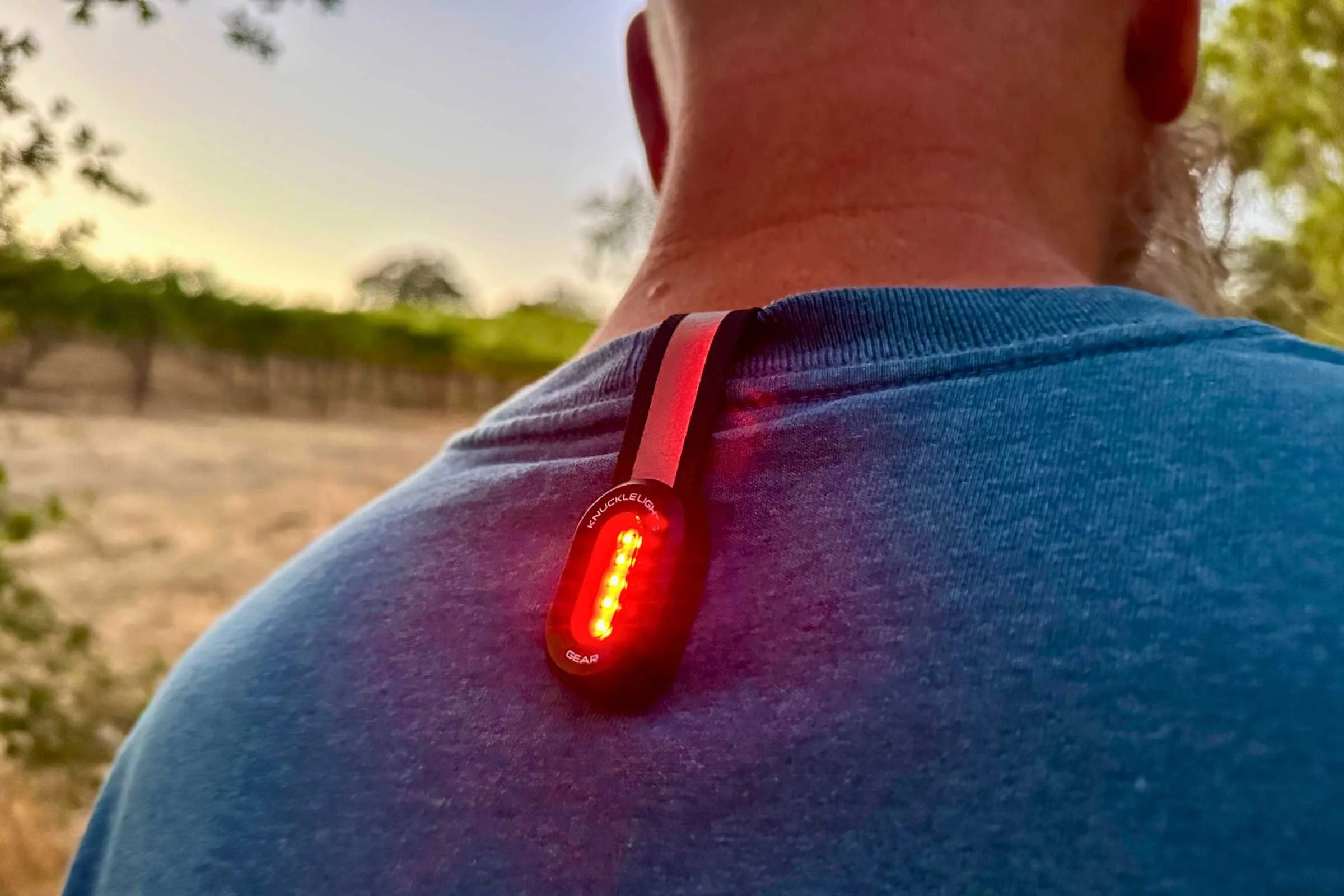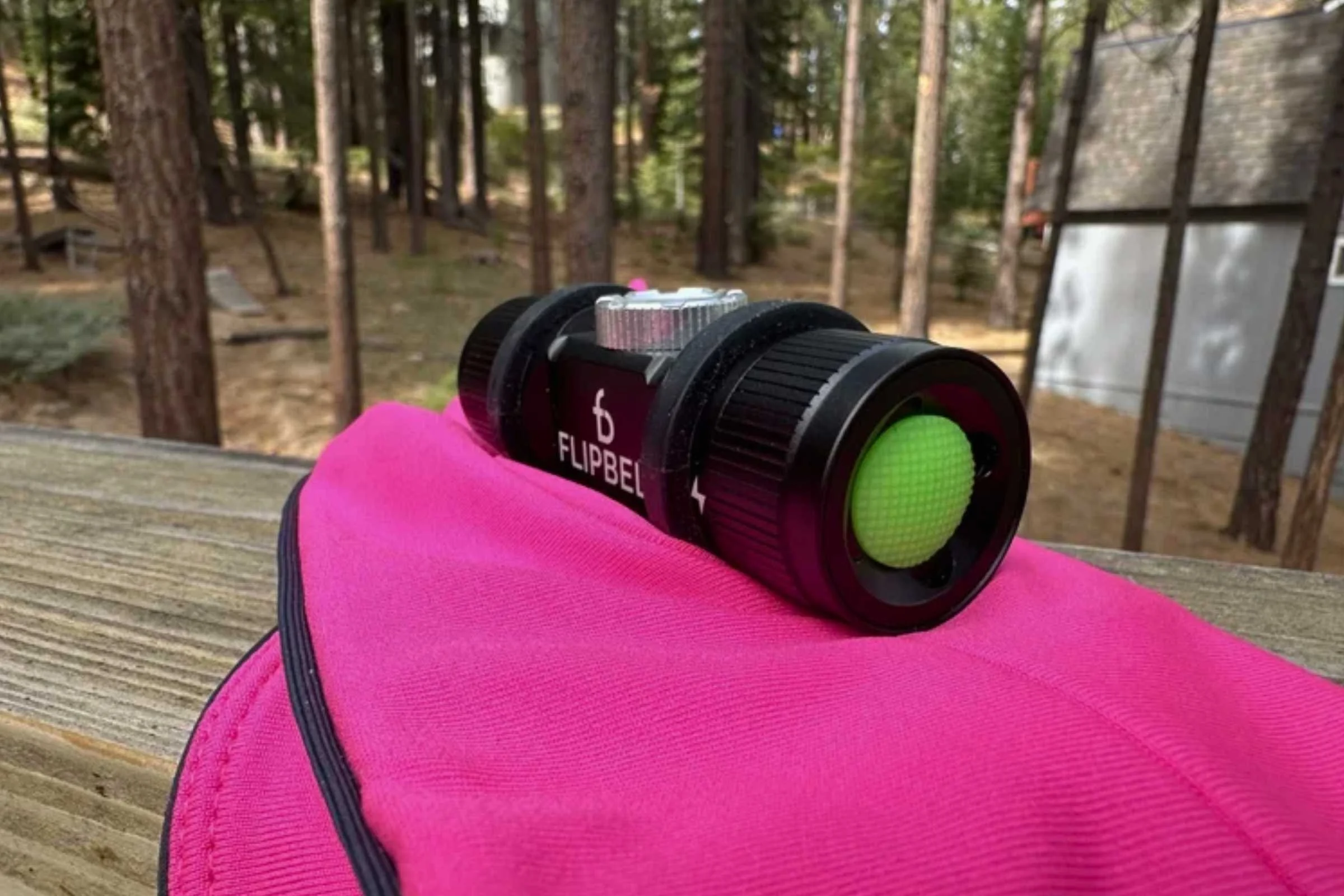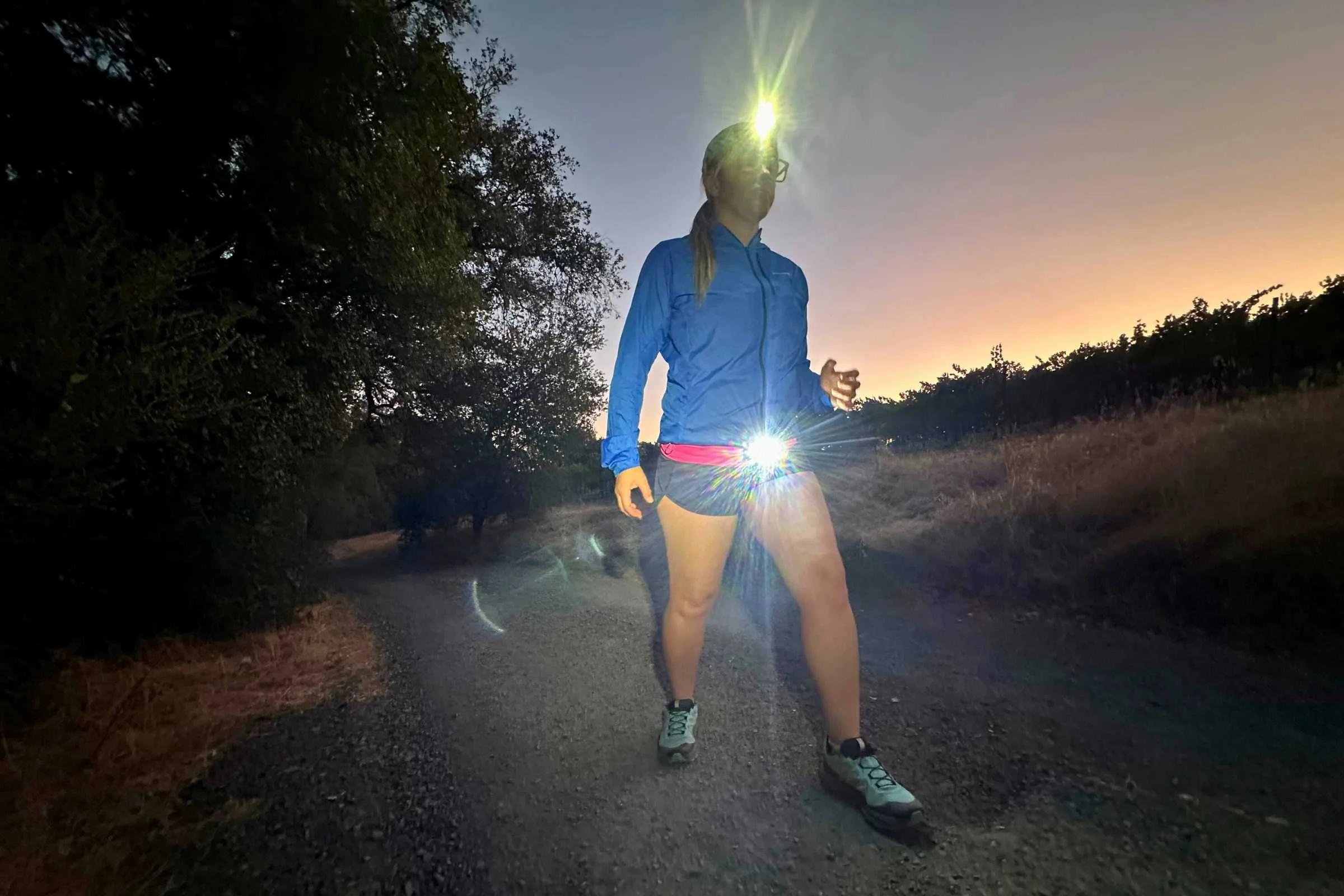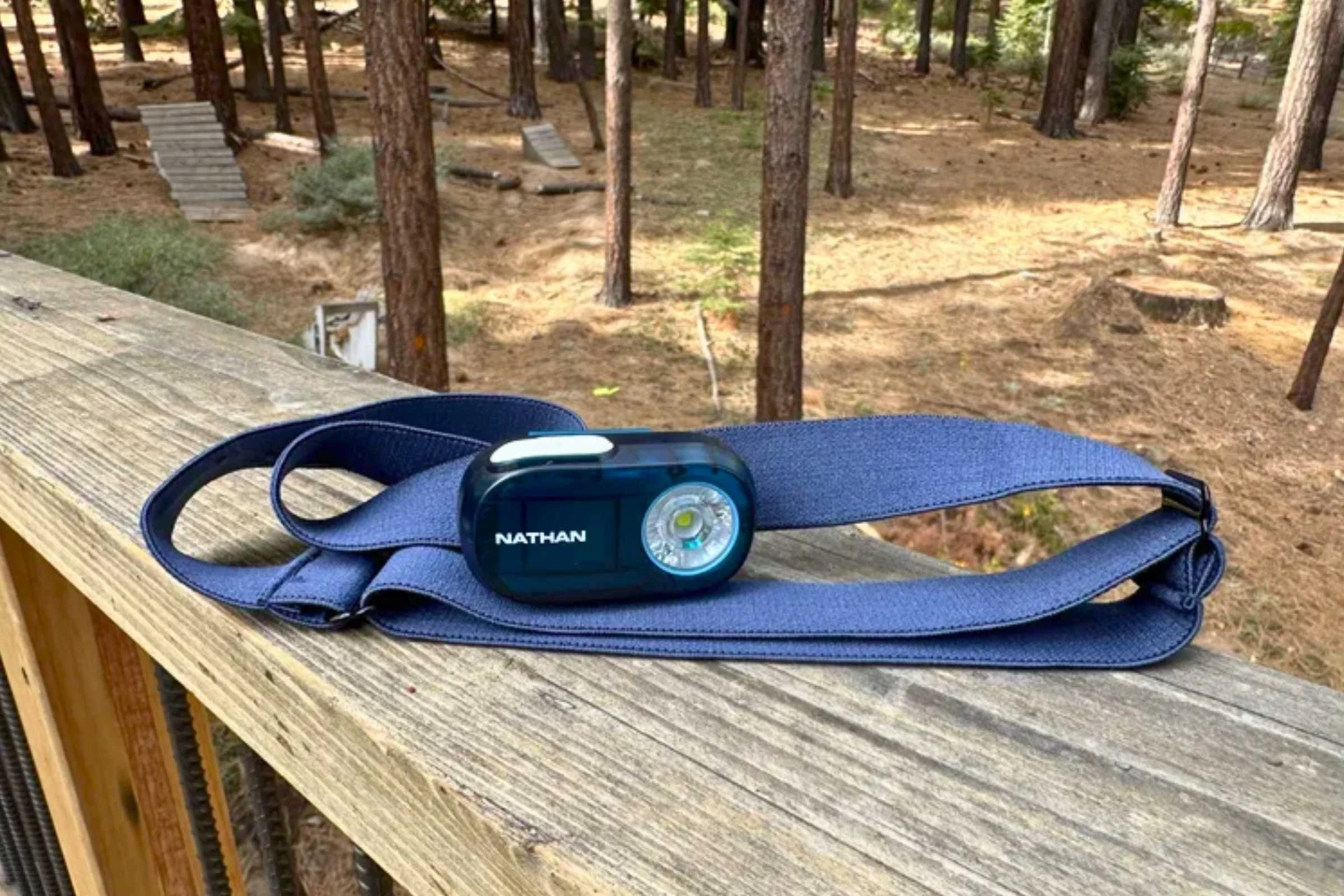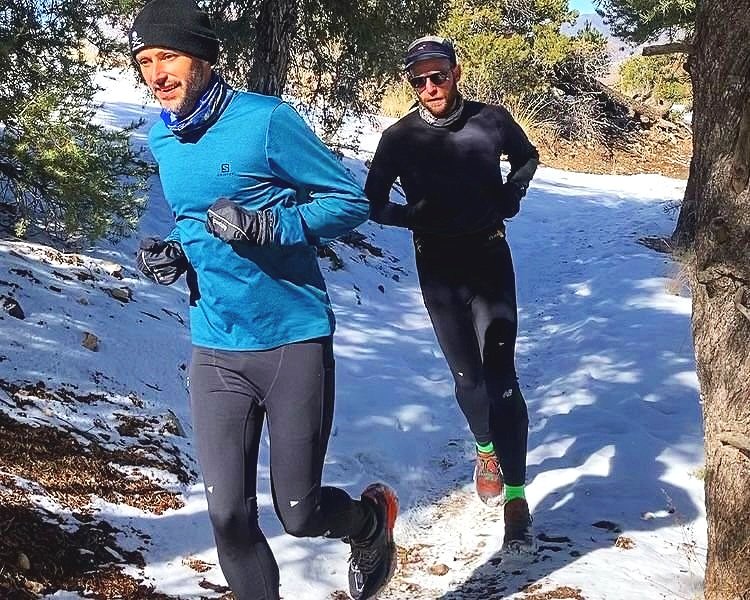Best Running Lights of 2025
The best lights, headlamps, handhelds, and rear lights for running at night
The PowerTap on the Black Diamond Distance 1500 lights up the darkest trails. Photo by Billy Pudoff.
September 25th, 2025, updated with a new winner for chest light and road running headlamp, 4 new models tested, to add FAQ, and to remove discontinued models
Home > Gear Reviews > Electronics
Running after dark doesn’t have to mean risking a stumble—or worse. The best running lights arm you with solid visibility and safety, offering the right mix of brightness, comfort, visibility from cars, and dependability to keep your rhythm going on roads and trails alike.
Treeline’s team tested 18 headlamps, 3 handhelds, 4 wearables, and 4 visibility lights during nighttime and early-morning runs—including motion drills to ensure they’d stay secure even during rough strides. That hands-on testing across real running scenarios helped reveal which lights truly perform when it counts.
Our evaluation zeroed in on key elements: brightness (to see), visibility (to be seen), battery life, durability, and fit. We prioritized lights that excel in ergonomics—fitting snugly, minimizing bounce, and handling sweat or rain—so runners could trust them on fast miles or group outings.
Top Pick: The Black Diamond Distance LT 1100 earns Treeline’s Best Overall award. It delivers a powerful PowerTap beam up to 1,100 lumens, reliable battery life, multiple color options, and a weatherproof IP67 design—all wrapped in a light, stable headband that stays put and keeps you both lit and confident in every running condition.
We deem running lights an essential running accessory for running in the dark. If you are getting up early before the sun rises and need an extra light to get started, or running in the evening after work or to avoid the lingering heat, we have you covered so you can see the road or trail in front of you and be seen by others.
We create reader-supported, objective, mission-driven gear reviews independently selected by our editors. This story may contain affiliate links, which help fund our website. When you click on the links to purchase gear, we may get a commission – without costing you an extra cent. Thank you for supporting our work and mission of outdoor coverage for every body! Learn more.
Running lights comparison table
| RUNNING LIGHT | TREELINE AWARD | CATEGORY | TYPE | WEIGHT | MAX LUMENS | VISIBILITY | BATTERY LIFE | BATTERY LIFE INDICATOR | IP RATING | RECHARGEABLE |
|---|---|---|---|---|---|---|---|---|---|---|
| Black Diamond Distance LT 1100 | Best Overall Read why |
See | Headlamp | 108 grams | 1100/600 | 125/110 meters | power tap on 1100 and 4.25 hours on 600 | Yes | IP67 | Removable Battery Pack charges with USB C |
| Black Diamond Distance 1500 | Best Brightest Read why |
See and Be Seen | Headlamp with Backlight | 213 grams | 1500/800 | 117/95 meters | 1.7 hours on 800 | Yes | IP67 | Removable Battery Pack charges with USB C |
| Petzl NAO RL | Best Overnight Racing Read why |
See and Be Seen | Headlamp with Backlight | 145 grams/5.11 ounces | 1500 reactive/900 standard | 200/140 meters | 2.0 hours for both | Yes | IPX4 | Removable Battery Pack charges with USB C |
| BioLite Dash 450 | Best for Road Running Read why |
See and Be Seen | Headlamp | 2.75 ounces | 450 lumens | 90 meters | 3 hours on high, 60 hours on low | IPX4 | Internal USB-C battery charges in two hours | |
| Black Diamond Deploy | Best Lightweight Read why |
See | Headlamp | 39 grams | 325/180 | 52/40 meters | 2.5 hours/4.3 hours | Yes | IPX4 | Internal battery USB-C |
| NiteCore NU25 400 | Best Affordable Read why |
See | Headlamp | 56 grams/1.98 ounces | 400/200 | 64/45 meters | 2.66 hours/4.66 hours | Yes | IP66 | Internal battery USB-C |
| Coast Hi-Vis Lighted Vest LH150 V2 | Best Chest Light Read why |
Be Seen | Wearable Rope Light | 2.4 ounces | None stated | N/A | 18 hours | Yes | IP54 Splash Resistant | Rechargeable internal USB-C battery |
| Knuckle Lights Advanced | Best Handheld Read why |
Worn | Handheld | 143 grams both together | 280 | not stated | 4 hours | No | IPX6 | Charging dock with Micro-USB |
| Nathan Hyperbrite RX | Best Tail Light Read why |
Be Seen | Tail Light | 17 grams | 16 | 731 meters | 30 hours | No | IPX4 | Micro-USB |
The winners
Best Overall running light: Black Diamond Distance LT
Lumens: 600 max, 1100 Power Tap
Weight: 108 Grams
Battery source: Rechargeable Li-ion battery
Waterproof: IP67
Rechargeable: USB-C
What we liked: Power Tap 1100 Lumens, longer battery life, multiple color modes, highest waterproof rating of the lamps we tested, great balance of weight vs. lumens
What we didn’t like: Price, battery cannot be charged separately from lamp
The Black Diamond Distance LT is our best overall running light since there isn’t a dark running situation where we would leave this one behind.
This headlamp has four color options: warm white, red, green and blue light. The Black Diamond Distance LT excels running on road, trail, highly technical terrain and overnight racing. With multiple light colors, red is great for preserving night vision, the green for reading topo maps and the blue for foggy situations. It is also dimmable, and has strobe lighting.
The battery life is about 3 hours on high, which is long enough for most regular night training runs, but not long enough for ultras or marathons. The battery meter lets you know when you are getting low so you won’t be stuck running in the dark.
Black Diamond Distance LT
The PowerTap with 1100 lumens is convenient and easy to use, especially for those scary “what is that up ahead” moments only to find out it is a tree stump and not a bear. We found ourselves using the PowerTap feature for fun quite a bit just to test it out, and found it makes a huge difference — you can see the whole trail light up with a decent peripheral. PowerTap is useful for unfamiliar areas of trail to get acquainted quickly and to find our car at the trailhead much faster.
The elastic headband is comfortable and holds the headlamp in place with minimal bounce. It does hold sweat and needs to be dried out after a hard run. If it gets really wet it needs to be tightened during the run.
This headlamp has lots of features and it is worth reading the directions to get the most out of this light. For example, the headlamp separates from the battery, but the charging port is on the headlamp, not the battery. So you can’t charge a spare battery on its own without the light attached. This makes it more difficult to get spare batteries charged before a big event.
The Black Diamond Distance LT headlamp also won best running headlamp in our Best (and Brightest) Headlamps guide).
Best Brightest Running Light: Black Diamond Distance 1500 Headlamp
Lumens: 800 max, 1500 PowerTap
Weight: 213 grams
Battery source: removable battery
Waterproof: IP67
Rechargeable: Battery comes off for charging and extras can be purchased
What we liked: Power Tap to 1500 lumens lights up the whole trail in a second
What we didn’t like: Price, (I want to summarize that it has a ton of features beyond what the normal user would need and that it is the most complicated or complex of all the headlamps we tested but I can’t think of the right phrase or word to put here so I am writing this long note instead as a reminder to put that in later or if you are reading and have an idea please share with me).
This headlamp is a beast; it has the most features and brightest lumens of all the lights we tested. At 213 grams it is the heaviest of all the headlamps we tested, but it was shockingly comfortable to wear, it comes with a removable top strap for extra support. We found that we didn’t need the extra top strap for most occasions. During testing it was comfortable to wear with the added top strap and allowed us to feel more secure about not losing our headlamp on a technical trail. We were surprised that the top strap didn’t interfere with our long haired testers' ponytail.
Black Diamond Distance 1500 Headlamp
The top strap provides extra support on the Black Diamond Distance 1500 and the red light is great for group settings. Photo by Billy Pudoff
To reach the brightest function of this lamp you literally just tap the side of the light and it gives you full power, it is really fun to play with, we enjoyed it as a way to make the run more fun, power tapping to see what was ahead and waiting until we ran to the area where the light reached, like a mini fartlek but with light.
We love the different colored light options in this headlamp red, blue and green in addition to the white light. Similar to the Black Diamond Distance 1100 the colored lights help with activities beyond running on the trail like group settings and reading maps.
The battery pack on the back of the lamp helps distribute the weight evenly so it feels well balanced when running. Additional batteries are available for purchase and can be charged separately from the headlamp. The pack at the back curves to hold comfortably against our testers heads. This was also comfortable for both long hair and short haired testers. The optional top strap worked nicely with a ponytail or braid, the red rear blinker is off to the side so a ponytail above it is not obstructing the safety lights. We love that it has the rear blinkers built in for extra safety and visibility.
You have to read the instructions that come with this light. It has a lot of features and lighting options that are hard to figure out on their own. Some of the other lights we tested were much simpler to use out of the box. We also love that this headlamp came with its own padded zippered case, convenient for storage and travel. This headlamp is on the heavier side so it can be overkill for shorter runs so it likely won’t be the only headlamp you need in your stash.
Best Overnight Racing Running Light: Petzl NAO RL
Lumens: 900 standard, 1500 reactive
Weight: 145 grams
Battery source: Removable rechargeable battery
Waterproof: IPX4
Rechargeable: USB-C
What we liked: Reactive Lighting saves battery life, lighter weight than others of similar brightness, rear red light with separate on/off button
What we didn’t like: Harder to wear with ponytail and long hair, No front red light option
Reactive lighting works to conserve battery life and gets brighter when you need it. We had fun testing this by looking at our feet and then the trail far into the distance and watching the light get brighter almost instantly. The reactive lighting is super fast and responsive. Removable battery with extras available for purchase.
Lighter weight than the other 1500 headlamps we tested, which is great for overnight racing where grams count. Rear light has a red light bar across the battery that has its own switch for on/off/strobe controls. Single button operation in front of light is simple to use. This headlamp has an optional top strap for added support. We found this headlamp to be well supported without the top strap, but it did add some support when we tested it.
Petzl NAO RL
As you cycle through the levels of light the light goes into an off mode before coming back on. Some testers did not like that it turned off completely when they wanted to change the brightness, they found it harder to change without stopping or slowing down.
There is not a red light option on the front of the headlamp, making this a less desirable option for some.
As noted above, the rear battery clip is rather tall and may affect long haired users with ponytails or braids. The lightweight elastic also got stuck in long hair on occasion.
Best for road running: BioLite Dash 450
Type: Headlamp
Weight: 2.75 ounces
Max Lumens: Visibility: 450 lumens 90 meters
Battery life: 3 hours on high, 60 hours on low
IP Rating: IPX4
Rechargeable? Internal USB-C battery charges in two hours
What we liked: Visibility in front and behind with backlight, well balanced design, lightweight
What we didn't like: Not as waterproof as other models
The Dash is the newest BioLite series with a rear light and rear battery. We like this model for road running because the rear light helps you remain visible to traffic behind you. The battery pack is well balanced with the light in the front for little to no bounce while running.
We also like that the BioLite Dash 450 is easy to charge with a portable battery pack while you run. Since the charging port is in the back, you can easily tuck a portable battery into a running pack and keep your headlamp and your legs running into the night.
You can read more in our in-depth, long-term review of the BioLite Dash 450 headlamp.
BioLite Dash 450



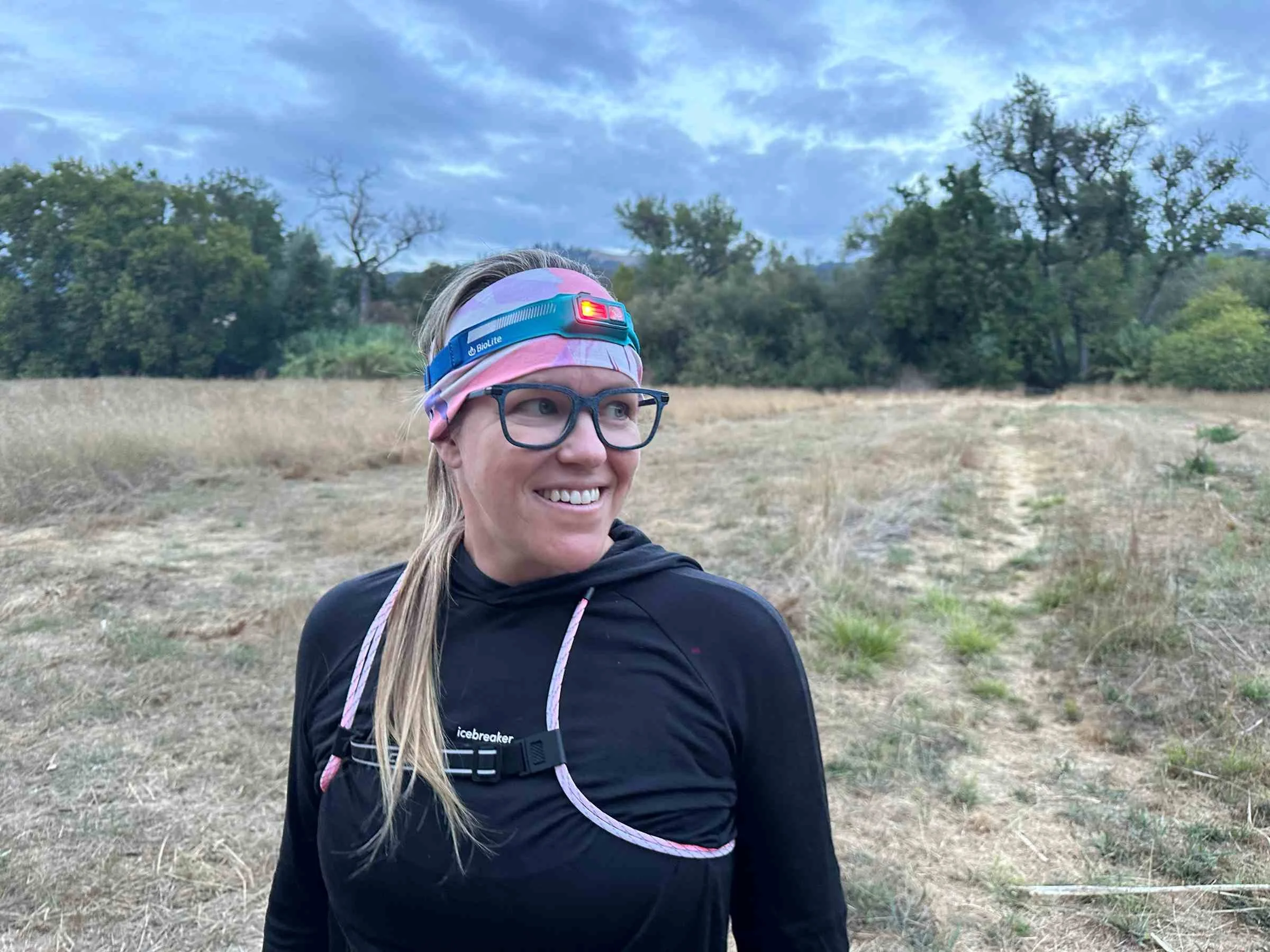
Although both headlamps have back lights, we liked the BioLite Dash 450 more than the BioLite 800 Pro we’ve also tested because it is 2.75 ounces compared to the 5.3 ounces of the 800 Pro, making it significantly lighter and less bulky.
The BioLite Dash light has five angles and lightly clicks into each one. We like that once you choose an angle it stays put until you change it.
Our testers both with long hair and without hair found this to be comfortable to wear against the skin. The elastic band gets a little more grippy the more you sweat, helping it stay in place on long hot runs. We also appreciate the IPX4 water resistance rating so it can stand up to a bit of rain and sweat.
Overall, with rear light visibility and pass-thru charging, we like this light for running on the road–it is light and comfortable.
Best Lightweight running light: Black Diamond Deploy
Lumens: 325, 180
Weight: 39 grams
Battery source: rechargeable by USB-C
Waterproof: IPX4
Rechargeable: yes
What we liked: Tiny and packable, wearable under a brimmed hat
What we didn’t like: Fewer lumens, shorter battery life
The Black Diamond Deploy is small and mighty. We loved so many things about it we had a hard time running without it. We loved this light for those late afternoon runs where you aren’t sure if you will make it home before dark, or those morning runs where you start out a few minutes before the sun fully rises. It is great for that inbetween season where you aren’t always running in the dark.
This light is designed to be worn under a baseball-style hat and nestle right under the brim, perfect for an incognito light once the sun comes up. No one can tell you have it on.
Black Diamond Deploy
The Black Diamond Deploy is designed to fit snugly under the brim of a hat. Photo by Sara Kruglinski.
There is no reason not to stash this light in your running gear, and it is also great as a backup headlamp since it is so light and small. It is very comfortable to wear and does not bounce around. There is a little padding where the light meets your forehead for comfort.
We really liked this light for road runs where you have some streetlights available to help light your way. However, 325 lumens isn’t quite bright enough on its own to be a stand alone light on long trails.
The battery life is also shorter than others, but the trade off is that this is super lightweight.
Best Affordable Running Light: NiteCore NU25
Lumens: 400 max, (200, 60, 6 lumens on high, medium, and low modes)
Weight: 56 grams or 1.98 ounces
Battery source: Rechargeable
Waterproof: IP66
Rechargeable: USB-C port
What we liked: Lightweight, white/red lights, can switch out
headband
What we didn’t like: No replacement headbands available from Nitecore
The NiteCore NU25 running headlamp is the best affordable run light. It has both white and red lights — the white light can be focused as a spotlight on the right, or a floodlight on the left or both at the same time for maximum output. There is also a solid red light and red strobe mode which is really nice to have in such an affordable model.
This light is very comfortable to wear and lightweight, making it easy to carry for those runs early or late in the day where you get a little bit of sun and darkness. The headlamp is easy to stash in a pocket or wear over your hat, and is easy to forget it’s even there.
This headlamp is also super easy to charge with a USB-C port located on the left side. There is a four dot battery meter as well so you will know when you need to start conserving power. With an IPX6 water resistance we felt confident that this light could withstand any sweaty or rainy run.
Note that Nitecore has released a new version called the Nitecore NU25 MCT (multi-color temperature). This allows you to match color settings with other runners during group runs. We're currently testing the new model and some retailers (Garage Grown Gear) have already started selling the MCT. We will report back but aside from MCT, most of the specs are the same.
NiteCore NU25
We love the red light mode that the NiteCore NU25 offers. Photo by Sara Kruglinski.
The headband glows in the dark, making this simple to find at night. The actual light can be unclipped from the included headband so you can wear the reflective headband by itself or clip it to one you already own and like better. Oftentimes the headband with our headlamps can wear out before the light itself and this makes it simple to switch things up.
There is no padding between the headlamp and your forehead other than the strap. Some testers chose to wear a buff under this headlamp to make it more comfortable. For a budget option though, the light, modes, and general comfort is great.
Best Chest Running light: Coast Hi-Vis Lighted Vest LH150 V2
Category: Be Seen
Type: Wearable Rope Light
Weight: 2.4 ounces
Max Lumens: Visibility: None stated
Battery life: 18 hours
IP Rating: IP54 Splash Resistant
Rechargeable? Rechargeable internal USB-C battery
What we liked: 360 degrees of visibility with the wearable rope light, multiple color options
What we didn't like: Not as bright as other lights, may cause chafing if worn without a barrier under it.
The Coast LH 150 V2 vest is wearable lights for running in the dark or low light conditions. We liked this for populated areas where people and cars might be a concern. There are six different colored light settings, including a multi-colored light. The lights follow the length of the rope all around your torso, making them visible from any angle for better safety. The battery life varies for each color.
We like that this vest is a lightweight way to help you to be seen by others, and they work well when paired with a headlamp or hand-held light. Some runners may find the lights to cause chafing when worn close to the skin–we found that we were unable to wear them with a tank top or short sleeves for that reason. This vest pairs best with a long sleeve shirt or jacket. The vest is adjustable and can fit over a running pack or vest for longer outings.
Coast Hi-Vis Lighted Vest LH150 V2



We like the flexibility to be able to be seen in a variety of running situations. The lights are brightest closest to the battery, which is located on the center of the back when you are wearing them and slowly taper off in brightness towards the front. We didn’t find this to be a deal breaker since we have secondary illumination on the front most of the time anyway in order to see where we are going.
These lights also can work to illuminate a dog, or be worn around the neck like a glow necklace–the adjustability of them allows for some creative applications beyond the intended vest style. The clip lets you clip them onto just about anything–we have even used this vest to light up a tent like a set of string lights.
Overall with the choice of colors and flexibility of ways to wear, the Coast LH150 V2 vest is our choice for best chest light.
Best Handheld running light: Knuckle Lights Advanced
Lumens: 280 together
Weight: 143 grams together
Battery Source: Rechargeable on charging dock
Waterproof: IPX6
Rechargeable: yes
What we liked: Comfortable to use, adjustable for different sized hands
What we didn’t like: You have to charge these on the included dock and if you misplace it you can't charge them an alternate way.
Everyone who tested the Knuckle Lights Advanced seemed genuinely surprised at how much they loved running with them. It was fun to hand these to a tester and watch their face light up with delight.
These lights are in the handheld category, but they actually are being held outside your hands. They wrap around your fingers and knuckles, leaving your hands free to grab other things. It is nice to have something on your hands but still have the use of your hands for other things as you are running. We were able to check our GPS watch and the map on our phone while holding these lights.
These are truly a grab- and- go light. There are three settings: a high, low and strobe. Simple to use, no directions are necessary.
Knuckle Lights Advanced
The two lights click together with magnets, making it easy to hold them in one hand if needed for extra light. With two lights — one in each hand — there was no change to the brightness of the path in front of us as we were running, since one light would be pulled back and another would come forward.
There was also something comforting about holding something that could be potentially useful in a self-defense situation, though that is not what these lights are intended for. But as a woman who runs alone (especially in the dark), it gave me a sense of added safety.
We also loved these lights because they were able to fit a wide variety of users — even those with very large hands could use them on the largest setting. We also like that they come in pairs. You can share one with a friend in a pinch if their light goes out.
Best Tail running light: Nathan HyperBrite RX
Lumens: 16
Weight: 17 grams
Waterproof: IPX4
Rechargeable: Micro USB
What we liked: Size and price
What we didn’t like: So small and light it is easy to lose
Not only is the Nathan HyperBrite RX a cute tiny light, it’s also affordable. We love the simple single button operation and it clips pretty much anywhere you need it to go. We even clipped it to one of our headlamps that did not have a rear light.
This light has four modes, and a simple click of the button takes you to the next mode. The three blinking modes help increase visibility from drivers on the roads at night and save battery.
This is a light you wear not for your benefit to see, but to make sure that you are seen from behind. This light does the job. It is bright and lightweight and it is easy to forget that you are wearing it. We have also used these on dog leashes and collars for added visibility for our running buddies.
Nathan HyperBrite RX
The Nathan HyperBrite RX fits on the back of the FlipBelt for extra visibility. Photo by Billy Pudoff.
Other running lights we tested
Nathan Luna Fire 400 RX
Lumens: 400, 300
Weight: 62 grams with the strap
Battery source: Internal rechargeable by USB-C
Waterproof: IPX4
Rechargeable: Yes
The Nathan Luna Fire 400 RX was our former winner for best chest light. We loved the versatility of the Nathan Luna Fire 400 RX. There are multiple ways to wear this light — it comes with an elastic strap that can be adjusted to fit around your chest, waist, or hips. You can also remove the strap and clip it to your shirt or running vest. One Treeline Review tester even tried it on their hat and it worked there as well.
After another year of testing other options, we decided we liked other chest lights for running better. The Nathan Luna Fire bounced more and has a shorter battery life than most lights. The included chest strap was looser than we liked, but the light can clip on to any strap you already own or a running vest. When we used this on our running vest it was much more stable.
Nathan Luna Fire 400 RX
Adjusting the strap the Nathan Luna Fire 400 RX chest band running light. Photo by Sara Kruglinski.
Category: See
Type: Headlamp
Weight: 2.6 ounces
Max Lumens: 400 lumens
Visibility: 90 meters
Battery life: 6 hours on high, 200 hours on low
IP Rating: IP67
Rechargeable? Internal USB-C Battery
The BioLite Range 400 has a single light in the front with a quick-charge battery for those times when you forget to charge after your last outing. We love how comfortable this headlamp is to wear–the band is super soft and has no points of irritation, and we were able to wear it against our skin without any issues. You can read more in our In-Depth Review of the BioLite Range 400 headlamp.
Our testers with long hair didn’t report any issues with hair getting caught in the headlamp, it was also comfortable for our tester without hair to wear against the skin and not have any points of irritation.
BioLite Range 400


This headlamp has a well-balanced build for running without any movement from the headlamp. It stays where you need it. The Range has a more adjustable tilt compared to previous BioLite models, like the 800 Pro and the Dash 450. There are five positions that click into place with a little more range between each click.
We also like the quick charge USB-C option. Charging 8 minutes gives you one hour of use on high. This is perfect for those times when the battery is drained and you still want to get a quick run in. By the time you drive to the trailhead, you should be able to get a decent amount of charge on your headlamp for a one-hour run.
This model is also IP67 waterproof submersible, so it is great for those stormy running situations.
The reason the BioLite Range 400 didn’t win any categories is it isn't as bright as other running lights we tested and isn't as affordable or lightweight as other 400 lumen options. We think it is a great hiking and everyday headlamp, but for runners, we think it is worth getting something more specialized. However, this was the most comfortable headlamp to wear long term while running–so comfortable we have even fallen asleep while wearing it–and a worthwhile option to consider.
Lumens: 800, 500
Weight: 150 grams
Battery source: 3,000 mAh Li-ion Rechargeable Battery
Waterproof: IPX4
Rechargeable: yes, and pass-through charging works with included cable
What we liked: Pass-through charging and comfortable band
What we didn’t like: Heavier than others with similar lumens
The BioLite 800 Pro is highlighted in our Best Reflective Gear for Running in the Dark guide. This is a great running headlamp, the band is the softest and most comfortable of all the headlamps we’ve tested. We love how it feels next to our skin — there was no need to add a layer underneath it. The band also reacts well with sweat, increasing in stickiness a bit so we didn’t have to make as many adjustments to it while running and sweating.
See our in-depth review of the BioLite 800 Pro headlamp for more information.
BioLite 800 Pro
We appreciate the large area of rear lights for visibility on the road and trails. The rear light is controlled with a separate button so you can turn it on and off as needed to save battery. Having both front and rear lights is a plus, since that is less gear to remember out the door.
Additionally, we love the pass-through charging on this headlamp, allowing us the ability to run all night with it by connecting it to an external battery pack. We also appreciate how bright this light is and how well it lights up the trails.
This was a contender for best overall, but we found the rear pack a little bulky, especially when you compare it to the Black Diamond Distance 1100 which has more lumens with no rear battery pack. It also isn’t as water resistant as the Black Diamond 1100, which for sweat and rain is an important factor for us.
This light is a solid choice for any runner, it is bright enough for most users and has multiple light modes for types of trail and road.
Lumens: 800, 500
Weight: 74 grams
Battery Source: Removable Battery
Waterproof: IP66
Rechargeable: Yes and AAA batteries can be used in a pinch
What we Liked: Has both warm and cool-toned white light, lightweight for 800 lumens
What we didn’t like: Durability concerns
The NiteCore UT27 800 Pro is bright and lightweight for its 800 lumens. Although it is an Amazon's Choice pick and bestseller, we didn't find it to be as good as other running lights we tested.
It has three color choices for light, a white and a yellow (warm) light in addition to a red light. The two buttons at the top are labeled W for the white light and Y for the yellow light, making it very simple to use out of the box. This was the only running light we tested with two button options for light like this. The yellow (warm) light is designed for rain, snow or foggy conditions. We also liked using the yellow light on open trails. One tester commented that yellow light may be better for those who get migraines or nausea when running with a headlamp.
NiteCore UT27
The battery compartment on this headlamp wasn’t the best, but the warm and cool tone light options were awesome.
We found the battery compartment difficult to open and not intuitive to use, it feels very flimsy — so much so that we are worried about breaking it and long-term durability. Our testers with larger hands also had a really hard time getting it open.
Also, we needed to wear a barrier between this headlamp and our skin to make it comfortable. The band has a single line of silicone that dug into our forehead and left an indentation after running. Other bands had different patterns of silicone and used different materials, so we didn’t have this issue with others.
Lumens: 500, 100
Weight: 79 grams
Battery Source: Removable Petzl Core Battery
Waterproof: IPX4
Rechargeable: Yes and AAA batteries can be used in a pinch
What we liked: Very lightweight and bright
What we didn’t like: Uncomfortable
The Petzl IKO CORE is extremely popular with trail runners for its ultralight build. It can be worn around the neck or as a headlamp. It has a unique design with a silicone band that holds it in place. One of our testers wore this headlamp on a 100-mile overnight ultramarathon. They really liked the lightweight band and that it did not hold onto sweat as they were running. This headlamp allows for micro adjustments of the angle instead of a few preset clicks. Overall this was not a winner for us but it is still an excellent running light ,and very bright at 500 lumens.
Petzl IKO CORE
However, our glasses-wearing tester found this really uncomfortable to wear with their glasses. The rear battery pack was also harder for our long haired tester to wear comfortably without getting hair stuck in the cord.
The Petzl IKO CORE has a battery compartment in the back. Photo by Billy Pudoff.
Another tester noted that after extended wear the band rubbed a raw spot on their ear. Comfort could be a tradeoff for high lumens in this ultralight design.
Lumens: 400, 300
Weight: 134 grams
Battery Source: internal rechargeable battery Micro USB
Waterproof: IPX4
Rechargeable: Yes
What we liked: Bright, good in snow and rain, red rear blinker
What we didn’t like: Hard to use hands while holding it
One of our testers has an older version of the Nathan Polaris 400 RX running flashlight that they have used for over ten years (and it still charges!). This flashlight has a rear red blinking light and an angled front light. It has a comfortable hand strap so you don’t have to worry about dropping it or gripping too hard while you are running.
Nathan Polaris Hand Torch 400 RX
The Nathan Polais 400RX has straps so you can relax your hands a bit while running. Photo by Sara Kruglinski
We love this light during snow or rain storms; the lower angle allows us to see the ground better than headlamps. This new version is brighter with a nice focused beam and was comfortable to run with for testers with large and smaller hands.
For road running we carry this in our street adjacent hand for extra visibility to cars. The rear blinker light helps increase visibility to drivers on the road. This is a great entry level light for those who are used to running with a traditional flashlight with the added benefit of a comfortable strap so you can relax your grip.
As much as we love this light it wasn’t our winner because you are still holding a flashlight in your hand and using this prevents you from being able to easily check maps on your phone or GPS watch like we could with the Knuckle Lights Advanced.
Lumens: 350, 210
Weight: 3 ounces
Battery Source: Rechargeable with micro USB
Waterproof: IPX4
Rechargeable: Yes
What we liked: Small, simple design
What we didn’t like: Some testers with larger hands were unable to use this light comfortably.
We really enjoyed testing the Knuckle Lights One light. It is small and easily fits into a pack or waist belt when you aren’t using it. We loved that it was rechargeable with just a cord and didn’t require a separate dock like the Knuckle Lights Advanced. This light was fun to hold and reminded our testers of drills where you run while holding eggs.
Knuckle Lights One
There are two different ways to grab the light. We liked positioning the light between our middle and pointer fingers. It can also be held with four fingers wrapped around it and the thumb resting on top.
We found that we could stash this light into our waistband and still have it shine on the path while we checked our maps or ate a quick snack.
The thin wrist strap was helpful to prevent accidental drops and made us feel like it was secured to us. But because it didn’t work for our larger handed testers we could not make this light a winner. We do still recommend this light as a great option especially for road running or urban areas.
Lumens: 6
Weight: 43 grams
Battery Source: Internal battery Micro USB
Waterproof: IPX4
Rechargeable: Yes
We liked that the Nathan Lightbender RX safety light features three colors of steady or blinking light so we could be visible while running. It also features a larger visible area so when worn around the arm you are visible from more angles.
However, we found this uncomfortable to wear with short sleeves or tank tops and needed to layer a sleeve or jacket underneath it.
Nathan Lightbender RX
The Nathan Lightbender RX has blue, red and green light. Photo by Billy Pudoff
Lumens: 16
Weight: 23 grams
Battery Source: Coin Battery CR2032
Waterproof: IPX4
Rechargeable: No
The Nathan HyperBrite Orb Strobe is easy to clip on and affordable. Four light modes allow you to be seen. It can clip on the back of a waist band or running vest or hip pack even a hat.
However we prefer the newer version with a rechargeable battery.
Nathan HyperBrite Orb Strobe
The Nathan HyperBrite Orb Strobe clips to the back of a shirt (or short/jacket) and pairs with the red light from the Petzl NAO RL rear light. Photo by Sara Kruglinski
Lumens: Unknown
Weight: 19 grams
Battery Source: Coin Battery CR2032
Waterproof: Not stated
The Knuckle Lights Tail Light Safety Blinker is the smallest light we’ve tested. It has a red and white light. This light attaches with a magnet and has a loop which works really nicely on the back of a running vest.
While a great size, we would prefer a rechargeable version of this light. We also felt that it could be a little brighter.
Knuckle Lights Tail Light Safety Blinker
Lumens: 400 max, (200, 60, 6 lumens on high, medium, and low modes)
Weight: 56 grams or 1.98 ounces
Battery source: Rechargeable
Waterproof: IP66
Rechargeable: USB-C port
The new NiteCore NU25 MCT 400 has multiple color temperatures (MCT), improving on the classic NU 25. The multiple color temperature LED lights allow you to switch between warm, neutral, and cool lights. We like that feature for group runs. Some people find it disorienting and dizzying to run with a group that has a mix of white and yellow lights, so this allows more coordination between runners.
The ability to switch between warm, neutral, and cool lights also gives you more control over visibility in different conditions. For example, the warm light works better in fog and rain. Cool white is better for visibility. Warm, neutral, and cool all come in three different brightness levels and there is also a red light mode.
Most of the other features are nearly identical to the Nitecore NU 25 headlamps that we tested. We're currently testing the new MCT model and will report back soon.
NiteCore NU25 MCT 400
What to look for in a running light
Our top five running headlamps. Photo by Sara Kruglinski.
Brightness (Lumens)
The lumens will dictate the brightness of the light. Most running articles recommend at least 500 lumens when you are running in complete darkness. I also like to consider the color of the light, a seemingly white light can be either yellow, white or blue in tone. The color of the light can make a difference especially if you are prone to headaches or nausea. I find that when I am using multiple lights it is best if they are all a similar color, mixing a blue headlamp with a yellow handlight can make me nauseous.
Some of the lights we tested, like the NiteCore UT27, have an option to switch between white and yellow light. You can then mix the headlight with a handheld or waist light that matches those colors.
Beam pattern
Many of the headlamps we tested have the option for a focused beam or for a flood light or a mix of both. The focused beam is great for spotting obstacles on the trail directly in front of you but you lose peripheral vision. Using the flood light allows for excellent peripheral vision and spotting turns on technical trails but you get less intense light right in front. Using both allows for the best of both lights, letting you see your surroundings and see the trail in front of you nice and clear.
The handheld and wearable lights are mostly a focused beam, making them a great addition to a headlamp with floodlighting.
The NiteCore UT27 has both warm and cool white light making it unique. Photo by Billy Pudoff.
Battery life
One of the most important factors after brightness is the battery life. Some of the ultralight models that we tested lacked long battery life and would not last a full overnight run. This may not matter to a runner whose runs are never longer than the shortest battery life expected on a lamp. Unlike backpacking lights where charging can be a hindrance at night, if you are running and going back to civilization every night it is easy to plug in your lamp and keep it charged for the next run.
Many of the lights we tested have a reserve battery, to prevent you from running out of light during your run. The lights will only go to full power when the battery is above a certain percentage of charge. This is another reason to always keep them fully charged before each run.
Rechargeability
Most of the lights we tested are rechargeable or feature rechargeable batteries. This is an important factor that we consider as disposable batteries have a long term impact on the environment. There were a few exceptions but those were mostly the tail lights and the nickel batteries last a very long time before they need replacing.
Weight
After considering brightness and battery life, weight is probably the next on the list in terms of importance. The brighter the headlamp and the longer the battery life, the heavier it will typically be, though there are a few exceptions in the mix. You just have to find a balance of these three factors that works for your needs. For example, the Black Diamond Decoy is one of the lightest lights that we tested, but the battery life is also one of the shortest as well as the lumens are some of the lowest.
Comfort and fit
The lights we tested vary in style and considerations need to be looked at as far as how you plan to wear a headlamp, with or without a hat or if you have long or short hair. We tested the headlamps on both long and short-haired individuals and with and without hats to see how they performed.
Weather resistance (Waterproof/Weatherproof)
Most of the lights we tested came with an IP rating of water resistance. If you are someone who perspires a lot or if you plan to run in a lot of rain and snow this is a very important factor to consider. The new BioLite Range 400 headlamp is fully waterproof with a submersible IP67 water rating.
Durability
There may be a trade off between durability and weight in some of the lights, lightweight lights may have more plastic instead of metal components and require more care to prevent breakage.
The Black Diamond Distance LT has many settings, including a blue light. Photo by Billy Pudoff.
Ease of use
One button, two buttons, three buttons, multiple modes… If you don’t plan on using all of the fancy modes that some of the higher end models come with, a simpler one-button model might be the right choice. For shorter runs we preferred lights that were easy to charge with easy to use basic features.
Visibility features (Reflectivity/Additional Lighting)
The rear lights come with a few different options. You can have a steady light or a blinking light. The blinking light preserves the battery life and also has the benefit of being more noticeable to cars driving by.
We like using the steady light when we are running with a group on a trail and our running mates find the steady light nicer to follow than the blinking lights. On the road, we want to be seen and noticed by fast moving cars and the blinker is helpful. Most testers were unable to see their own blinky light since it was in the back and were able to run unbothered by any blinking.
To learn more about how to stay visible in the dark, check out our Best Reflective Gear for Running in the Dark guide.
Adjusting different lights in the front and rear to stay visible. Photo by Billy Pudoff.
Adjustability (Beam angle/Brightness levels)
Most of the lights we tested have some way to change the angle and direction of the light. Where you place the light will depend on your personal preference, speed, and terrain. We usually like to be able to see a few seconds ahead of us and depending on how fast we are going that may be a shorter or longer distance ahead.
Size and portability
The Knuckle Lights Tail Light Safety Blinker has a magnet loop. Photo by Sara Kruglinski.
These lights are generally sized bigger the brighter they are and the longer the battery lasts. Get the light that makes sense for the type of running you plan to be doing.
One of our testers runs in the morning and only needs a headlamp for about 30 minutes before the sun rises, something less robust like the Black Diamond Deploy is perfect in this situation. Those of us who end up running later in the evening and even starting in the dark need a brighter light, and smaller lights aren’t going to cut it for hours in the dark.
Price and value
Our affordable winner is a great option for any runner, if you aren’t sure that night running is for you, you can start with the affordable winner and then add a waist light or handheld as you get more into it. The ability to add lights to your set up can help keep the financial investment lower.
The goal should be to have the ability to have at least 500 lumens in order to see the trail clearly and handle speed at night, but this doesn't mean you can’t run with a 400 lumen headlamp to start.
How to choose the right running light for you
All the lights we tested for this story, worn together to make us extra bright. Photo by Sara Kruglinski.
Consider your running environment: Road runners have it the easiest when it comes to front illumination. Most roads are even surfaces compared to the trails, and may even have reflective markers. Trail runners, especially those who like to run in unfamiliar terrain, will need more lumens than those who are running on roads or even with the assistance of street lights. You will have to think about the type of running that you want to do in the future. Those who run with others will benefit from a lamp with a red light option, as it is always polite to use the red light around others.
Evaluate battery life: Select a light with sufficient battery life for the duration of your runs, especially if you do long-distance or trail running. Think about the longest runs you usually do during your week, you likely will be using a mix of the highest setting and middle settings during your runs especially as you get more comfortable with night running. If you are planning an ultra or overnight race, you don’t have to invest in a 1500 lumen light. Some of our more affordable options have easily swappable batteries and you can carry a few extras to get more hours on trail.
Prioritize comfort: Opt for a light that fits securely and comfortably, with adjustable straps or clips that suit your preferences. If you have the option try them on in the store and do some jumping jacks or jog in place to see how the headlamps fit and handle the bouncing. In winter we run with a beanie, which adds a layer of cushion, but in summer months on 100 degree days we run at night to escape the heat. When we wear the headlamp without a layer, it is important to be able to wear them next to our skin/hair if we are using them in warmer weather.
Check for weather resistance: Ensure the light is waterproof or weatherproof if you frequently run in rainy or wet conditions. Running in the rain or snow is a great experience with the right gear (link to treeline story here). Weather resistance also applies to sweat. I hate worrying if my sweat is going to damage my headlamp. If you don’t have this problem, I tip my hat to you, but if you are like me consider a higher waterproof-rated headlamp or light so you can sweat without stress.
Look for adjustable brightness levels: Choose a light with adjustable brightness to adapt to different lighting conditions and conserve battery life. The Petzl lights have a reactive light setting to save battery life giving you just enough light to see where you are looking. Lights with adjustable settings help save battery life allowing you to use dim or lower settings on areas where you don’t need the extra light to see.
The FlipBelt has single-button operation for simplicity and ease of use. Photo by Sara Kruglinski.
Assess portability and weight: Consider the size and weight of the light, particularly if you prefer something lightweight and compact. The smaller, more portable lights are great even if you don’t plan to run in the dark. I like carrying the Knuckle Lights One in a pack just in case it gets dark. The Black Diamond Deploy is another tiny option that fits easily in a pocket or vest until you need it.
Think about versatility: If you need a light for multiple activities, look for a multi-purpose option that can switch between headlamp, handheld, or clip-on modes. The Petzl IKO CORE is a unique option that can be worn around the neck or as a headlamp. Many of the lights we tested came with a white bag so you can use it in a tent or for camping as diffused lighting. We like the Knuckle Lights for late-night dog walks in addition to our runs.
Tips for running with a light
The Black Diamond Distance LT with the FlipBelt make a bright combo for running in the dark. Photo by Billy Pudoff.
Position the light properly: It may take a few minutes of your run to figure out the proper positioning for your lights. Depending on your speed you may want the beam of the light to be farther in front of you rather than focusing on your feet. Think of where you normally look when you run, and start with aiming the light there.
Use multiple lights: There are many advantages to having multiple lights at once. With two lights you don’t have to stress about burning out the battery since you have a backup. Using two front lights like a headlamp and waist light or handheld can increase the depth of field especially for technical trails. I always recommend wearing a tail light so you are visible from behind. They are affordable and lightweight.
Check battery life: Most of the lights we tested only work on full power when they are fully charged and then they go into a reserve mode with lower power as they get closer to running out of battery. This reserve mode is super helpful so you are less likely to get stuck someplace in the dark. To avoid having to use reserve mode at the beginning of your run make sure the light is at full power, if they are locked you can usually tap a button to trigger the battery meter to blink the current charge.
Adjust brightness: This is a fun one. You are either going to be running in the dark and hopefully watching the sun come up, which means you can start with the brightest light and slowly taper it off as the sun rises. This method is also recommended for any runs that start in the full dark sky, start with a bright light as as your eyes adjust it becomes easier to taper off to the lower light levels. Some evening runners will start with a lower light setting as the sun sets and increase brightness as it gets dark on an evening run.
Secure the light for comfort: To preserve the straps on your lights, try to use them on a looser setting and tighten them up as needed. Some of the lights were more comfortable under a headband or clothing.
Test in different conditions: I tested all the lights in a dark bedroom with no mirrors before trying them on a run. I wanted to make sure I was going to have enough light to see the trails once it got really dark. I also tested them in my backyard at night running in place and making sure I was able to see the light and that my hat/hands/knees weren’t blocking the beam.
Carry a backup: If you have two lights you already have a backup. Some of the lights we tested have extra batteries and they are lightweight to carry for long runs.
Mind your pace: Don’t expect to run your usual pace at night, especially at first. It is slower for most people, even accomplished ultrarunners slow their pace at night. It is harder to see, so don’t be discouraged.
Use red light mode: Red light mode is wonderful for preserving night vision, and for pre or post-run hang outs with your running crew. Red light is also helpful for sneaky off-trail bathroom breaks.
The four lights we tested here are all meant to help others see you while you are running. Photo by Sara Kruglinski.
Stay visible to others: The tail light and rear lights on some headlamps are essential for any nighttime road running so you can be seen. The blinky lights can be seen from 2,400 feet away. On the trail, the blinky lights can help runners behind you keep track of you and make you visible to SAR if needed in an emergency.
Snow and rain: Handheld and waist lights are generally better than headlamps for snow and rain. The lower angle to the ground helps cut the “star wars” effect of the snow or rain falling. Again, clip-on lights can be great for this. Use the focused spot beam instead of the floodlight. Sometimes lower lumens can make it easier to see. Running in snow and rain are usually going to be slower runs, but it can be a really fun experience.
The FlipBelt Running Light adjusts up or down so you can see the trail clearly in front of you, with the Black Diamond Distance LT. Photo by Billy Pudoff.
FAQ
-
Most runners need at least 500 lumens for safe trail running in complete darkness, while road runners can get by with 300-400 lumens. Trail runners tackling technical terrain should aim for 600-800+ lumens for adequate visibility of obstacles and trail features. Road runners benefit from lower lumen lights since they have more predictable surfaces and often some ambient lighting. Consider your typical running environment - urban areas with streetlights require less brightness than remote forest trails.
-
Headlamps provide hands-free convenience and consistent lighting, while handheld lights offer better ground visibility in rain and snow. Headlamps work best for technical trails where you need peripheral vision and hands free for balance. Handheld lights excel in weather conditions because the lower angle reduces glare from precipitation. Many serious night runners use both - a headlamp for primary lighting and a handheld or chest light for depth perception and backup.
-
Choose lights with battery life that exceeds your longest typical run by at least 25% for safety margin. Most recreational night runs last 1-3 hours, making lights with 4+ hour battery life ideal. Ultra-runners need 8+ hours or swappable batteries for overnight events. Battery life decreases significantly on maximum brightness, so factor in your typical usage patterns. Many lights have reserve modes that provide dim emergency lighting when the main battery depletes.
-
Spot beams provide focused long-distance visibility for seeing obstacles ahead, while flood beams offer wide peripheral vision for technical terrain. Spot patterns work best for road running and straight trail sections where you need to see far ahead. Flood lighting helps with technical trails, turns, and close-up footing work. Many premium lights offer both patterns or a combination mode that provides the benefits of each for maximum versatility.
-
Yes, rear lights are essential for visibility to vehicles on roads and helpful for group trail running. Rear lights make you visible to drivers from up to 2,400 feet away, providing crucial safety on any road running. Even on trails, blinking rear lights help running partners follow you and make you visible to search and rescue if needed. Most rear lights weigh less than an ounce and last 20+ hours, making them worth carrying on every night run.
-
Ensure proper fit with snug but comfortable straps and consider your light's weight distribution. Headlamps with rear battery packs typically bounce less than front-heavy designs. Tighten straps gradually during your run as you warm up and sweat increases grip. For chest or waist lights, position them close to your center of gravity. Very lightweight options under 2 ounces rarely cause bouncing issues regardless of fit.
-
Most quality running lights handle rain well with IPX4 or higher water resistance ratings. Look for IP66 or IP67 ratings if you frequently run in heavy rain or sweat heavily. These ratings protect against water jets and brief submersion. Running in rain or snow works better with handheld or chest lights positioned lower than headlamps, as the angle reduces glare from precipitation hitting your light beam.
-
Red light preserves night vision and shows courtesy to other runners, but provides less trail visibility than white light. Use red light when approaching other runners, in group settings, or when you need to preserve night vision for stargazing. Switch back to white light for technical terrain where you need maximum visibility. Red strobes work well for rear visibility lights while being less distracting than white strobes.
Running lights care and maintenance tips
Various lights use different types of batteries, charging methods, straps, and ways to wear. Photo by Sara Kruglinski.
Most of the lights we tested have rechargeable batteries, it is important to not “overcharge” the batteries and unplug them once they are fully charged. We like to throw ours on the charger post run and check back after an hour or two so it is ready to go for the next run.
Your headlamp will probably be pretty sweaty after a good run, so you will want to make sure it is dry before putting it away for storage. Many of the lights we tested came with storage bags. We use the bags to keep everything together and to protect the light from getting scratched or scuffed.
If your light has a lock setting, use it so you don’t accidently drain the battery before your next run. There is nothing worse than getting ready for an evening run and realizing your lamp is dead. Likewise, if you decide to get extra batteries for your headlamp keep the extras fully charged and check the battery life on your extras before you head out.
Most of these lights have rechargeable batteries that can drain in cold weather. I left a headlamp in my car in winter and found the battery dead, even though I had fully charged it last time after using it. I try to store my lights inside away from extreme temperature swings. For tips on winter running, check out our guide on How to Run in Winter — 13 Tips for Running in the Cold.
The Nathan Luna Fire 400RX has an adjustable elastic strap. Photo by Sara Kruglinski.
The elastic straps can wear out with excess salt from sweat. Depending on your waterproof rating you may need to spot clean your headband to keep it in top shape. A damp washcloth can do wonders removing sweat and salt. Make sure it is fully dry after cleaning.
How we researched and tested
All the Headlamps we tested for this story. Photo by Sara Kruglinski.
We spent hours researching lights for running and narrowed down our list to search for the best running lights. We read reviews on other sites, and talked to other runners, sometimes for hours, about their favorite lights and why they love them. We also considered lights for different types of running, weather, heat and cold, and terrain.
We narrowed down our list to our top running lights, and tested 25 running lights over two years. We took lights out running on the trail and road in a variety of conditions and weather. We did jumping jacks with wearable lights to see if they would fall off or bounce around.
We ran mostly in the evening hours into nighttime, getting to enjoy the stars outside, along with getting to see all the nocturnal animals on the trails. We also drained the batteries and charged them back up to see how easy they were to charge.
Our Testing Process
Comprehensive night running and controlled testing across diverse conditions
Testing Locations
- Nighttime trail runs
- Evening road running
- Early morning pre-sunrise
- Dark bedroom controlled tests
- Backyard movement testing
- Various weather conditions
What We Test
- Brightness & lumen output
- Battery life on all settings
- Comfort & secure fit
- Beam pattern (flood vs spotlight)
- Weather resistance (IPX ratings)
- Charging method & durability
About the author / Why you should trust us
Sara discovered running in high school and never really stopped. What started as a way to spend time with her dad before school in the mornings morphed into a lifelong love for the sport. She loves running marathons and half marathons both on road and trail and has a wall full of finisher medals. A self proclaimed night owl, she won’t be found running before sunrise unless she has paid for a race entry. Sara has spent many hours running at night, she loves the solitude on the trails and the cooler weather in the summer. In addition to running she can be found skiing, snowboarding in winter and backpacking or thru hiking with her dog in summer. As a former member of SAR, she believes that safety should always be a priority in any outdoor adventure and having lights for running, especially in winter when the days are so short, is essential.
To see all of Sara Kruglinski stories, check her author page.










